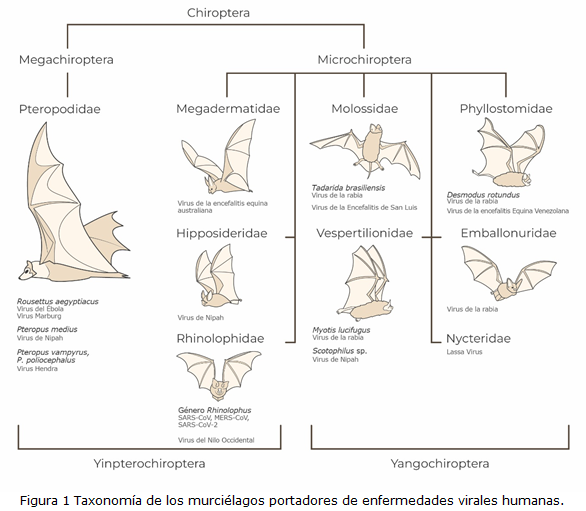Murciélagos como vectores de enfermedades virales e impacto en la salud humana
Resumen
Introducción: Los murciélagos se destacan por ser los únicos mamíferos voladores, con alrededor de 1 400 especies que cumplen un rol fundamental como controladores de plagas y polinizadores de plantas nocturnas. Sin embargo, su influencia sobre la salud humana se ha evidenciado cada vez más, en particular después del surgimiento de brotes epidémicos de enfermedades virales asociadas a estos mamíferos.
Objetivo: Analizar la influencia de los murciélagos en la salud humana, centrándose en su papel como portadores de enfermedades virales y su potencial como reservorios y vectores de enfermedades.
Métodos: Se realizó una revisión bibliográfica de la literatura utilizando descriptores MeSH y términos como: Animals, Wild Chiroptera, Virus Diseases, Zoonoses, Disease Vectors, Disease Reservoirs, Public Health, bats, Communicable Disease Control, Disease Outbreaks, Prevention and Control. Se revisaron 1 442 artículos en bases de datos y documentos oficiales, se seleccionaron las fuentes relevantes con Mendeley Desktop 1.19.4. y se obtuvieron al final 47 artículos.
Resultados: Existen varias especies de murciélagos que pueden afectar la salud del ser humano y que albergan en especial virus de las familias Filoviridae, Coronaviridae y Paramixoviridae. Los murciélagos se consideran incubadoras óptimas para la propagación de virus debido a su sistema inmune único que lo hace resistente a estos agentes infecciosos.
Conclusiones: La vigilancia y monitoreo de los murciélagos, junto con acciones de educación pública y una gestión adecuada de sus hábitats, son fundamentales para la detección temprana y prevención de la transmisión de nuevos virus de estos mamíferos a los humanos.
DeCS: QUIRÓPTERO/clasificación; VIROSIS; VIRULENCIA; PREVENCIÓN DE ENFERMEDADES; TOLERANCIA INMUNOLÓGICA.
Descargas
Citas
1. Loh EH, Nava A, Murray KA, Olival KJ, Guimarães M, Shimabukuro J, et al. Prevalence of bat viruses associated with land-use change in the Atlantic Forest, Brazil. Front Cell Infect Microbiol [Internet]. 2022 [citado 19 Abr 2023];12. Disponible en: https://doi.org/10.3389/fcimb.2022.921950
2. NBNatlas. Chiroptera Blumenbach, 1779 Bat [Internet]. London: National Biodiversity Network Trust; 2021 [citado 19 Abr 2023]. Disponible en: https://species.nbnatlas.org/species/NHMSYS0000376160
3. U.S. Department of Agriculture. Working the Night Shift - Bats Play an Important Role in Pollinating Crops [Internet]. U.S.: Department of Agriculture; 2014 [citado 19 Abr 2023]. Disponible en: https://www.usda.gov/media/blog/2014/10/29/working-night-shift-bats-play-important-role-pollinating-crops
4. Villalobos-Chaves D, Rodríguez-Herrera B. Frugivorous bats promote epizoochoric seed dispersal and seedling survival in a disturbed Neotropical forest. J Mammal [Internet]. 2021 [citado 19 Abr 2023];102(6):1507-13. Disponible en: https://doi.org/10.1093/jmammal/gyab114
5. Santos-Moreno A, Soriano-Cruz M. Diet of Natalus mexicanus (Chiroptera, Natalidae) in a semi-evergreen forest in Oaxaca, Mexico. Neotrop Biol Conserv [Internet]. 2019 [citado 19 Abr 2023];14(4):591-8. Disponible en: https://doi.org/10.3897/neotropical.14.e46957
6. Ahmim M, Moali A. The diet of four species of horseshoe bat (Chiroptera: Rhinolophidae) in a mountainous region of Algeria: evidence for gleaning. Hystrix [Internet]. 2013 [citado 19 Abr 2023];24(2):174. Disponible en: https://doi.org/10.4404/hystrix-24.2-8728
7. SCIENCING. What Are the Adaptations of a Bat [Internet]. California: Leaf Group Ltd; 2018 [citado 19 Abr 2023]. Disponible en: https://sciencing.com/adaptations-bat-8430727.htm
8. Cesare C. Bats open wide to focus their ultrasonic beams [Internet]. Israel: Hayadan; 2015 [citado 19 Abr 2023]. Disponible en: https://hayadan.com/bats-open-wide-to-focus-their-ultrasonic-beams-1105159
9. Sritongchuay T, Hughes AC, Bumrungsri S. The role of bats in pollination networks is influenced by landscape structure. Glob Ecol Conserv [Internet]. 2019 [citado 19 Abr 2023];20:e00702. Disponible en: https://doi.org/10.1016/j.gecco.2019.e00702
10. Olmedo ML, González Noschese CS, Seco Pon JP, Romero D. Trophic spectrum of Tadarida brasiliensis (Chiroptera: Molossidae) in the southeaster Buenos Aires Province, Argentina. Rev del Mus Argentino Ciencias Nat [Internet]. 2021 [citado 19 Abr 2023];23:1-13. Disponible en: http://dx.doi.org/10.22179/revmacn.23.715
11. Giménez AL, Omad GH, De Paz Ó, Giannini NP. Diet and resource partitioning in Patagonian bats (Chiroptera: Vespertilionidae and Molossidae). Mammal Res [Internet]. 2021 [citado 19 Abr 2023];66(3):467-80. Disponible en: http://dx.doi.org/10.1007/s13364-021-00574-7
12. Ramírez-Fráncel LA, García-Herrera LV, Losada-Prado S, Reinoso-Flórez G, Sánchez-Hernández A, Estrada-Villegas S, et al. Bats and their vital ecosystem services: a global review. Integr Zool [Internet]. 2022 [citado 19 Abr 2023];17:2-23. Disponible en: https://doi.org/10.1111/1749-4877.12552
13. National Geographic [Internet]. Belize: National Geographic; 2021 [citado 19 Abr 2023]. Meet the bat that eats other bats. Disponible en: https://www.nationalgeographic.com/animals/article/more-mysteries-revealed-about-bat-eating-bat
14. Burgueño-Sosa EE, Esquivel-Gómez LR, Rivadeneyra-Gutiérrez E, León-López AA. Generalidades de la familia Filoviridae y el virus del Ébola: una actualización de sus implicaciones en la población humana. Rev biomédica [Internet]. 2020 [citado 19 Abr 2023];31(1). Disponible en: https://doi.org/10.32776/revbiomed.v31i1.683
15. World Health Organization. Enfermedad por el virus de Marburgo [Internet]. Ginebra: OMS; 2021 [citado 19 Abr 2023]. Disponible en: https://www.who.int/es/news-room/fact-sheets/detail/marburg-virus-disease
16. Languon S, Quaye O. Impacts of the Filoviridae family. Curr Opin Pharmacol [Internet]. 2021 [citado 19 Abr 2023];60:268-74. Disponible en: https://doi.org/10.1016/j.coph.2021.07.016
17. Yadav P, Sudeep A, Gokhale M, Pawar S, Shete A, Patil D, et al. Circulation of Nipah virus in Pteropus giganteus bats in northeast region of India, 2015. Indian J Med Res [Internet]. 2018 [citado 19 Abr 2023];147(3):318. Disponible en: https://doi.org/10.4103%2Fijmr.IJMR_1488_16
18. Tsang SM, Low DHW, Wiantoro S, Smith I, Jayakumar J, Simmons NB, et al. Detection of Tioman Virus in Pteropus vampyrus Near Flores, Indonesia. Viruses [Internet]. 2021 [citado 19 Abr 2023];13:563. Disponible en: https://doi.org/10.3390/v13040563.
19. Wang J, Anderson DE, Halpin K, Hong X, Chen H, Walker S, et al. A new Hendra virus genotype found in Australian flying foxes. Virol J [Internet]. 2021 [citado 19 Abr 2023];18:197. Disponible en: https://doi.org/10.1186/s12985-021-01652-7.
20. Organización Mundial de Sanidad Animal. Manual Terrestre de la OIE. Enfermedades víricas de Nipah y Hendra [Internet]. París: OMSA; 2022 [citado 19 Abr 2023]. Disponible en: https://www.woah.org/fileadmin/Home/esp/Health_standards/tahm/3.01.14_HENDRA_&_NIPAH.pdf
21. World Health Organization. Nipah virus [Internet]. Ginebra: WHO; 2018 [citado 19 Abr 2023]. Disponible en: https://www.who.int/news-room/fact-sheets/detail/nipah-virus
22. Jacob Machado D, Scott R, Guirales S, Janies DA. Fundamental evolution of all Orthocoronavirinae including three deadly lineages descendent from Chiroptera‐hosted coronaviruses: SARS‐CoV, MERS‐CoV and SARS‐CoV‐2. Cladistics [Internet]. 2021 [citado 19 Abr 2023];37:461-88. Disponible en: https://doi.org/10.1111/cla.12454.
23. Alkhovsky S, Lenshin S, Romashin A, Vishnevskaya T, Vyshemirsky O, Bulycheva Y, et al. SARS-like Coronaviruses in Horseshoe Bats (Rhinolophus spp.) in Russia, 2020. Viruses [Internet]. 2022 [citado 19 Abr 2023];14(1):113. Disponible en: https://dx.doi.org/10.3390/v14010113
24. Letko M, Seifert SN, Olival KJ, Plowright RK, Munster VJ. Bat-borne virus diversity, spillover and emergence. Nat Rev Microbiol [Internet]. 2020 [citado 19 Abr 2023];18:461-71. Disponible en: https://doi.org/10.1038/s41579-020-0394-z
25. Xiong Q, Cao L, Ma C, Tortorici MA, Liu C, Si J, et al. Close relatives of MERS-CoV in bats use ACE2 as their functional receptors. Nature [Internet]. 2022 [citado 19 Abr 2023];612(7941):748-57. Disponible en: https://doi.org/10.1038/s41586-022-05513-3
26. Temmam S, Vongphayloth K, Baquero E, Munier S, Bonomi M, Regnault B, et al. Bat coronaviruses related to SARS-CoV-2 and infectious for human cells. Nature [Internet]. 2022 [citado 19 Abr 2023];604(7905):330-6. Disponible en: https://doi.org/10.1038/s41586-022-04532-4%0A%0A
27. Torres Machado BB, Domínguez Mirabet Y, Rodríguez Noa JA. La rabia como enfermedad re-emergente. Medicentro Electrónica [Internet]. 2019 [citado 19 Abr 2023];23(3):238-48. Disponible en: https://medicentro.sld.cu/index.php/medicentro/article/view/2688/2443
28. Centros para el Control y la prevención de Enfermedades (CDC). Evite el riesgo de contraer rabia de los murciélagos [Internet]. EE.UU: CDC; 2022. Disponible en: https://www.cdc.gov/rabies/es/murcielagos/index.html
29. Alegria-Moran R, Miranda D, Barnard M, Parra A, Lapierre L. Characterization of the epidemiology of bat-borne rabies in Chile between 2003 and 2013. Prev Vet Med [Internet]. 2017 [citado 19 Abr 2023];143:30-8. Disponible en: https://doi.org/10.1016/j.prevetmed.2017.05.012
30. Rohde RE. Common Myths and Legends of Rabies. Rabies [Internet]. 2019 [citado 19 Abr 2023];2020:69-78. Disponible en: https://doi.org/10.1016%2FB978-0-323-63979-8.00005-2
31. Cárdenas-Canales EM, Stockmaier S, Cronin E, Rocke TE, Osorio JE, Carter GG. Social effects of rabies infection in male vampire bats (Desmodus rotundus). Biol Lett [Internet]. 2022 [citado 19 Abr 2023];18(9):20220298. Disponible en: https://www.ncbi.nlm.nih.gov/pmc/articles/PMC9449815/
32. Monroy FP, Solari S, Lopez JÁ, Agudelo-Flórez P, Peláez Sánchez RG. High Diversity of Leptospira Species Infecting Bats Captured in the Urabá Region (Antioquia-Colombia). Microorganisms [Internet]. 2021 [citado 19 Abr 2023];9(9):1897. Disponible en: https://doi.org/10.3390/microorganisms9091897
33. Silva JA, Scofield A, Barros F de N, Farias DM, Riet‐Correa G, Bezerra Júnior PS, et al. Molecular detection of Histoplasma capsulatum in bats of the Amazon biome in Pará state, Brazil. Transbound Emerg Dis [Internet]. 2021 [citado 19 Abr 2023];68(2):758–66. Disponible en: https://doi.org/10.1111/tbed.13740
34. Sulser RB, Patterson BD, Urban DJ, Neander AI, Luo Z-X. Evolution of inner ear neuroanatomy of bats and implications for echolocation. Nature [Internet]. 2022 [citado 19 Abr 2023];602:449–54. Disponible en: https://doi.org/10.1038/s41586-021-04335-z
35. Springer MS. Phylogenetics: Bats United, Microbats Divided. Curr Biol [Internet]. 2013 [citado 19 Abr 2023];23(22):R999–1001. Disponible en: https://doi.org/10.1016/j.cub.2013.09.053
36. Dimka J, van Doren TP, Battles HT. Pandemics, past and present: The role of biological anthropology in interdisciplinary pandemic studies. Am J Biol Anthropol [Internet]. 2022 [citado 19 Abr 2023];178:256-91. Disponible en: https://doi.org/10.1002/ajpa.24517
37. Banerjee A, Baker ML, Kulcsar K, Misra V, Plowright R, Mossman K. Novel Insights Into Immune Systems of Bats. Front Immunol [Internet]. 2020 [citado 19 Abr 2023];11. Disponible en: https://doi.org/10.3389/fimmu.2020.00026
38. Lawrence P, Escudero-Pérez B. Henipavirus Immune Evasion and Pathogenesis Mechanisms: Lessons Learnt from Natural Infection and Animal Models. Viruses [Internet]. 2022 [citado 19 Abr 2023];14:936. Disponible en: https://doi.org/10.3390/v14050936
39. Wang J, Lin Z, Liu Q, Fu F, Wang Z, Ma J, et al. Bat Employs a Conserved MDA5 Gene to Trigger Antiviral Innate Immune Responses. Front Immunol [Internet]. 2022 [citado 19 Abr 2023];13. Disponible en: https://doi.org/10.3389%2Ffimmu.2022.904481
40. Ahn M, Cui J, Irving AT, Wang L-F. Unique Loss of the PYHIN Gene Family in Bats Amongst Mammals: Implications for Inflammasome Sensing. Sci Rep [Internet]. 2016 [citado 19 Abr 2023];6(1):21722. Disponible en: https://doi.org/10.1038%2Fsrep21722
41. Moreno Santillán DD, Lama TM, Gutierrez Guerrero YT, Brown AM, Donat P, Zhao H, et al. Large-scale genome sampling reveals unique immunity and metabolic adaptations in bats. Mol Ecol [Internet]. 2021 [citado 19 Abr 2023];30:6449–67. Disponible en: https://doi.org/10.1111/mec.16027
42. Subudhi S, Rapin N, Misra V. Immune System Modulation and Viral Persistence in Bats: Understanding Viral Spillover. Viruses [Internet]. 2019 [citado 19 Abr 2023];11(2):192. Disponible en: https://doi.org/10.3390/v11020192
43. Popov IV, Mazanko MS, Kulaeva ED, Golovin SN, Malinovkin AV, Aleshukina IS, et al. Gut microbiota of bats: pro-mutagenic properties and possible frontiers in preventing emerging disease. Sci Rep [Internet]. 2021 [citado 19 Abr 2023];11(1):21075. Disponible en: https://doi.org/10.1038/s41598-021-00604-z
44. Gonzalez-Isunza G, Jawaid MZ, Liu P, Cox DL, Vazquez M, Arsuaga J. Using machine learning to detect coronaviruses potentially infectious to humans. Sci Rep [Internet]. 2023 [citado 19 Abr 2023];13:9319. Disponible en: https://doi.org/10.1038/s41598-023-35861-7
45. Crook JM, Murphy I, Carter DP, Pullan ST, Carroll M, Vipond R, et al. Metagenomic identification of a new sarbecovirus from horseshoe bats in Europe. Sci Rep [Internet]. 2021 [citado 19 Abr 2023];11(1):14723. Disponible en: https://doi.org/10.1038/s41598-021-94011-z%0A%0A
46. Discover the mammals of Europe [Internet]. Nederland: Discover the mammals of Europe; 2021 [citado 19 Abr 2023]. Bat migration routes in Europe. Disponible en: https://discovermammals.org/bat-migration-routes-in-europe/
47. Wieringa JG, Carstens BC, Gibbs HL. Predicting migration routes for three species of migratory bats using species distribution models. Peer J [Internet]. 2021 [citado 19 Abr 2023];9:e11177. Disponible en: https://doi.org/10.7717/peerj.11177

Publicado
Cómo citar
Número
Sección
Licencia
La Revista Archivo Medico Camagüey, ofrece de forma inmediata después de ser indexada en el Proyecto SciELO; acceso abierto al texto completo de los artículos bajo el principio de hacer disponible y gratuita la investigación para favorecer el intercambio del conocimiento global y coadyuvar a una mayor extensión, publicación, evaluación y uso extensivo de los artículos que se exponen pudiendo ser utilizados, sin fines comerciales, siempre y cuando se haga referencia a la fuente primaria.
Carta De Declaración De Autoría u Derechos De Autor(a)
Conflictos de intereses: los autores deberán declarar de forma obligatoria la presencia o no de conflictos de intereses en relación con la investigación presentada. (Descargar Plantilla para declarar confictos de intereses)
La Revista Archivo Médico Camagüey se encuentra bajo una
Licencia Creative Commons Reconocimiento-NoComercial 4.0 International (CC BY NC 4.0).
Esta licencia permite a otros distribuir, mezclar, ajustar y construir a partir de su obra, incluso con fines comerciales, siempre que le sea reconocida la autoría de la creación original. Esta es la licencia más servicial de las ofrecidas. Recomendada para una máxima difusión y utilización de los materiales sujetos a la licencia. La licencia completa puede consultarse en: https://creativecommons.org/licenses/












